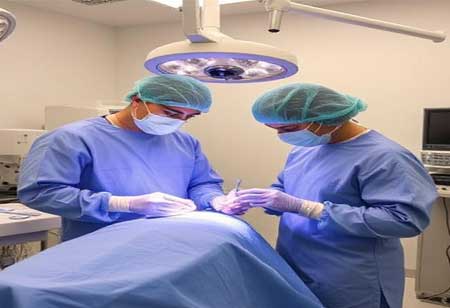Thank you for Subscribing to Healthcare Business Review Weekly Brief
Be first to read the latest tech news, Industry Leader's Insights, and CIO interviews of medium and large enterprises exclusively from Healthcare Business Review
The Evolution of Plastic Surgery and Regenerative Medicine in the Asia-Pacific Region

By
Healthcare Business Review | Wednesday, April 02, 2025
Stay ahead of the industry with exclusive feature stories on the top companies, expert insights and the latest news delivered straight to your inbox. Subscribe today.
Plastic surgery and regenerative medicine are rapidly advancing in Asia-Pacific (APAC), driven by cutting-edge medical research and increasing consumer demand. These disciplines converge to offer innovative solutions for both aesthetic and reconstructive needs, integrating regenerative technologies to enhance healthcare outcomes. With significant investments from governments, private enterprises, and medical institutions, the sector has experienced substantial growth in recent years.
Advances in Regenerative Medicine in Plastic Surgery
Regenerative medicine in plastic surgery focuses on restoring or replacing damaged tissues and organs to restore normal function. Key advancements, including stem cell therapy, tissue engineering, and bioengineered products, have significantly improved surgical outcomes. The application of autologous stem cells—harvested from the patient and reintroduced into their body—has facilitated personalized treatments, reducing the risks of complications and immune rejection.
Platelet-rich plasma (PRP) therapy is critical in regenerative medicine, providing minimally invasive solutions for skin rejuvenation and wound healing. Research collaborations among leading universities and laboratories across the APAC region have accelerated the development of PRP applications, making them increasingly sought after by patients and medical professionals.
Emerging Treatments and Techniques
In the APAC region, regenerative medicine is widely integrated into aesthetic and reconstructive plastic surgery. Fat grafting, which involves transferring a patient’s fat cells to restore volume in facial features or other body areas, has become a preferred technique. Enhancing fat grafting with regenerative components—such as stem-cell-enriched fat—has further improved clinical outcomes.
Additionally, advancements in 3D bioprinting technology have revolutionized reconstructive surgery, creating customized implants and support structures. This innovation is particularly transformative in craniofacial and post-cancer reconstruction, where personalized implants enhance surgical precision and aesthetic results.
The Growing Role of Biomaterials
The development and application of advanced biomaterials are reshaping the regenerative medicine landscape in plastic surgery. Bioengineered tissues and scaffolds promote natural healing and tissue regeneration, reducing reliance on synthetic substitutes. In the APAC market, governments and private-sector stakeholders are investing heavily in biomaterial research and commercialization, fostering the adoption of organic, long-lasting surgical solutions.
Furthermore, innovations in implant materials, including biocompatible silicone alternatives and regenerative scaffolds utilizing hydrogel technology, are becoming industry standards. These advancements enable a more seamless integration of plastic surgery and regenerative medicine, improving procedural outcomes and patient satisfaction.
The region is witnessing a significant surge in demand for regenerative plastic surgery, driven by medical advancements, increasing consumer awareness, and supportive regulatory frameworks. Countries like South Korea, Japan, China, and India are at the forefront of this transformation, with each market exhibiting unique characteristics. South Korea remains globally renowned for its aesthetic plastic surgery industry, integrating regenerative medicine into procedures for enhanced outcomes. Meanwhile, Japan and China have well-established reconstructive techniques markets catering to a diverse patient demographic. Emerging economies like India and Southeast Asian nations are also experiencing heightened interest, fueled by rising disposable incomes and a younger population receptive to aesthetic treatments, making regenerative plastic surgery more accessible and affordable.
Technological advancements have played a crucial role in shaping APAC's regenerative plastic surgery landscape. The rapid adoption of AI-driven diagnostic tools, augmented reality for implant precision, and robotic-assisted microsurgical techniques have significantly improved surgical accuracy and patient safety. Additionally, advanced data analytics enable clinics to monitor patient outcomes in real time, fostering continuous procedural enhancements and ensuring high-quality care.
Government support has been instrumental in accelerating innovations in regenerative medicine. Policymakers across the region, particularly in South Korea, China, and Japan, have launched initiatives to promote collaboration between research institutions, academia, and private healthcare providers. These efforts have resulted in advancements in stem cell therapy, platelet-rich plasma (PRP) applications, and bioimplant technologies. Many governments have also streamlined regulatory approvals for biomaterials and regenerative devices, fostering a conducive environment for technological breakthroughs and commercialization.
Education and training initiatives further bolster the sector’s growth, with leading medical institutions in APAC offering specialized programs in regenerative plastic surgery. These workshops and training modules equip surgeons with expertise in emerging technologies, materials, and procedural innovations, ensuring optimal patient outcomes and sustained industry progress.
Market dynamics indicate a steady increase in consumer awareness regarding regenerative plastic surgery. Social media and global marketing campaigns have shifted patient preferences toward minimally invasive procedures with enhanced recovery profiles. This growing demand has, in turn, fueled investments in the sector. Venture capital and private equity firms actively fund research in biomaterials, stem cell applications, and advanced surgical techniques, recognizing the region's potential as a hub for innovation. Cross-border collaborations among research institutions and clinics further enhance the quality and affordability of services.
In the subsequent years, the convergence of regenerative medicine with emerging fields such as gene editing and nanotechnology presents transformative possibilities for plastic surgery. Innovations like gene-editing techniques to accelerate tissue regeneration and nanomaterials for hyper-personalized surgical scaffolds could redefine industry standards. Additionally, regenerative treatments are expected to expand into non-traditional applications, including scar reduction, hair restoration, and anti-aging therapies, opening new frontiers for innovation and market expansion in the APAC region.






